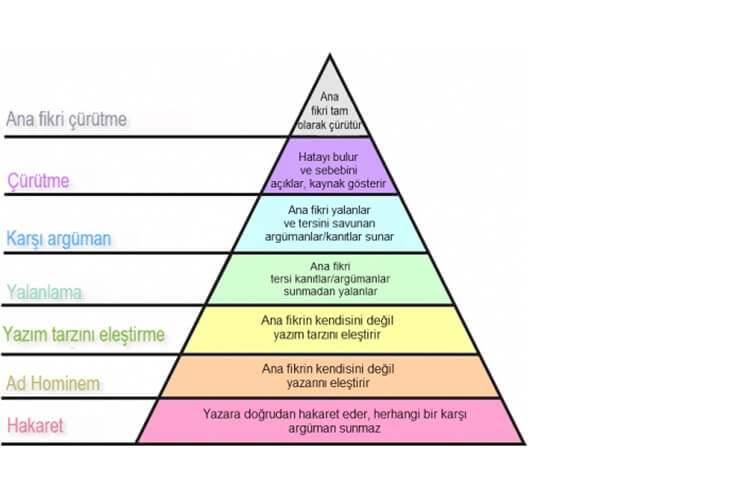If you are arguing about a subject and the person is trying to include an irrelevant argument into the discussion and reconcile it with the subject, you are exposed to Ad Hominem. Alright, What is Ad Hominem? What is Ad Hominem, what are its types and arguments? Together we take a close look.
What is Ad Hominem?
ad hominem (Latin for ‘to the person’), also called argumentum ad hominem or human slander fallacy. Generally this Latin term; refers to a rhetorical strategy in which the speaker attacks the character, purpose, or other characteristic of the person making the argument rather than attacking the essence of the argument. This creates a diversion on an irrelevant but often very loaded topic, preventing any real discussion.
The most common form of this error “Person A makes claim X. Person B claims Person A has an undesirable trait, and therefore Person B concludes that argument X is false.” is in the form.
Valid ad hominem arguments ; It occurs in an informal logic where the person making the argument is based on arguments from authority in the form of testimony, expertise, or a selective presentation of information that supports what he or she is arguing for. In this situation; counter-arguments can be made that the target is dishonest, does not have the claimed expertise, or has a conflict of interest.
Another valid type of ad hominem argument, generally encountered only in specialized philosophical use, refers to the dialectical strategy of using the target’s own beliefs and arguments against them, while disagreeing with the validity of those beliefs and arguments. Ad hominem arguments first in Ancient Greece examined. John Locke was later 17th century. century ad hominem arguments were reexamined.
The Function of Ad Hominem Arguments
Sometimes people use the ad hominem fallacy to directly appeal to other people’s feelings. As soon as you spot someone following you with an ad hominem argument, you can counter their attack in two moves:
- Note the irrelevance of the emotional testimony they just presented to the discussion. Show their personal attacks on you and emphasize that it has nothing to do with the argument at hand.
- After you uncover your weaknesses, move on. “I realize you think I’m A, B, and C, but that has nothing to do with what we’re discussing here.” You can present counter-arguments.
Types of Ad Hominem
There are several types of ad hominem fallacies. All of them follow a general scheme in which, instead of dealing with the gist of one’s argument or trying to refute it, the interlocutor attacks the character of the defender of the argument and concludes that the attack refutes the argument. Let’s take a closer look at these defamation argument types:
- 1) Person Slander Sophism: Associating the argument with the character or actions of the person making the argument, rather than the argument in the middle.
- Sample: Freud is one of the sexual perverts. So we don’t need to take what they say seriously.
- 2) Qualitative Person Slander: Contrasting the characteristics of the person making the argument, such as ethnic origin, political attitude, and religious view, instead of the argument itself.
- Sample: We cannot accept his proposal, because he is in the opposing party.
- 3) “You too” fallacy: Do not suggest that a claim is false because it contradicts a person’s claim or actions.
- Sample: You say I shouldn’t drink, but you’re always drunk too.
- 4) The Prejudice Fallacy: Discrediting a person’s arguments and creating prejudice by giving negative information (true or false) about a person beforehand.
- Sample: Ali became a famous lawyer, right? Just yesterday he couldn’t put the two words together.
Examples of Ad Hominem from many walks of life:
Let’s examine a few ad hominem examples. Unfortunately, ad homiem types are common in the courtroom and politics. So we will be looking at a few examples from these areas. Not surprisingly, arguments for ad hominem fallacy pop up in all sorts of everyday interactions.
So we will also review a few daily examples. The more you read about examples of defamation arguments, the more you will be able to identify them and defend yourself against such allegations if necessary.
in court
It won’t surprise you to learn that ad hominem attacks have been attempted in courts where the emotions of jurors are regularly played.
- Attacking the character of a defendant rather than addressing the facts of the alleged criminal activity:
- “You haven’t had a regular job since 1992. Worse still, we couldn’t find a single employer who would give you a good reference.”
- Using the witness’ geographic location to distort the case:
- “You lived here for a short time. Issues concerning Turkey are clearly beyond your grasp.”
- Using racial slurs to humiliate a person of another race in a discussion about a crime involving people of different races:
- “People like you don’t understand what it’s like to grow up black in America. You have no right to argue about the gang.”
- Attacking the character of the accused by showing his faults in a case:
- “You cheated on your wife and lied, but now you expect the jury to believe you?”
In Political Discussions
Have you ever watched political talk shows? Politicians may even resort to name-calling. Here are a few examples in this direction:
- Humiliating another politician when asked about a specific political event during a campaign:
- “Well, I think we need to look at Mr. Ali’s failures on this one.”
- Responding in any discussion by attacking one’s personal beliefs:
- “You don’t even go to the mosque. How can you claim to be a Muslim?”
- Attacking the opponent’s physical characteristics rather than looking for flaws in his policy:
- “Look at that type! How can a person vote for this?”
In daily life
A simple conversation can suddenly take a reverse turn and the person can enter scribbling territory. A seemingly innocent argument can inadvertently turn into a personal attack on someone else. Let’s look at a few more examples so you can keep your ad hominem detective skills in place.
- Using one’s education level as a tool to abuse and humiliate one’s argument:
- “You didn’t even finish high school. How would you know?”
- To belittle a teacher’s decision to grade by insulting her intelligence:
- “Well, you don’t look like you graduated from a good school, so I can understand why you don’t know how to properly grade a writing assignment.”
- Saying that someone’s age prevents them from having an intelligent or meaningful discussion:
- “You’re obviously too young to understand.”
- Using marital status to override the opinion of someone of a different status:
- “You’ve never been married. How can you judge someone with marital problems?”
- Noting that one’s ethnicity prevents them from formulating a valuable idea:
- “You’re Turkish, so you’ll never understand what it’s like to live in a country like this.”
Person defamation arguments often reveal people’s prejudices. Being able to identify ad hominem arguments can help you defend yourself accordingly. It is worth noting that in some cases a personal attack may be relevant to the current discussion. Perhaps by resorting to defamation arguments, you are pointing out a longstanding character flaw in someone else.
The problem is; these arguments are not always based on facts and concrete data, and often incorrectly translate into information not directly relevant to the discussion at hand. Therefore, try to avoid them and, of course, protect yourself from such attacks. If you find yourself in a position to fight an ad hominem attack, it’s also worth looking at whether you can include some ad hominem discourse.
What Does Wabi-Sabi Mean? What is the Wabi-Sabi Philosophy and How Is It Applied?




















